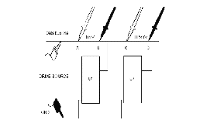
PCB test — locate bus shorts and loading faults with the TONEOHM 950's advanced bus fault finding ranges
|
||
| Printer Friendly Version | |
 |
Application Note 108
PCB test — locate bus shorts and loading faults with the TONEOHM 950's advanced bus fault finding ranges |
| Printer Friendly Version | |
| Locating obscure loading faults
and shorts on microprocessor buses on multi-layer circuit
boards can seem a daunting task. Combining a multi-range
shorts locator such as the Polar Instruments TONEOHM 950
with a systematic approach to the fault can help locate
the toughest short. Bus fault types Low
resistance shorts Measuring
track current Measuring
track voltage |
|
 Tracing a load by measuring track voltage |
In this circuit the databus line shown is being loaded by one of the ICs. Using the 950 Drive Source and the millivolt ranges, voltage between points A and B measures 1mV. Further along the track, voltage across points C and D measures 0.05mV. This suggests that U1 is loading the bus line, probably via blown input protection diodes. |
| Inaccessible shorts and loads Measuring track current is not always possible - many shorts will occur inside wire harnesses, beneath conformal coating or in densely packed boards. In these cases the 950's non-contact current TRACE facility can help locate shorts under an IC or on an inner layer of a multi-layer pcb. The 950 Drive Source drives current between two shorted tracks - the resulting magnetic field indicates the path of the current which can be easily followed with a current trace probe. To locate which device is causing a bus to stick low, connect one Drive Source lead as close to one end of the bus as possible, the other Drive Source lead to ground. Now trace along the bus line until the audible tone disappears - this point should be close to the device causing the "stuck at" fault. This method can be especially effective at locating which of several ICs is drawing excessive current. Plane shorts |
|
Polar Instruments Ltd polarinstruments.com Tel: +44 1481 253081 Fax: +44 1481 252476 © Polar Instruments 2002 |
 |
| © Polar Instruments 2002. Polar Instruments pursues a policy of continuous improvement. The specifications in this document may therefore be changed without notice. All trademarks recognised. | |